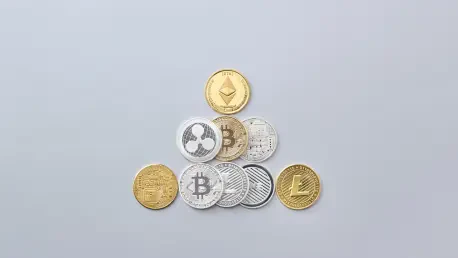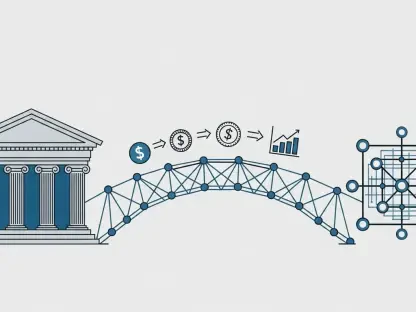Imagine a world where owning a piece of prime real estate or a government bond is as simple as clicking a button, with fractional shares accessible to investors globally in seconds. This isn’t a distant dream but a rapidly emerging reality through the tokenization of real-world assets (RWAs), a process that converts physical and intangible assets into digital tokens on a blockchain. As financial markets race to adopt this transformative technology, one platform frequently emerges as a frontrunner: the XRP Ledger (XRPL). This roundup dives into diverse opinions and insights from industry leaders and blockchain experts to uncover why XRPL is often hailed as an ideal choice for RWA tokenization. By comparing perspectives on its unique features, challenges, and potential, this discussion aims to provide a comprehensive view of its role in reshaping asset management.
Unveiling the Strengths of XRP Ledger for Tokenization
Built-In Decentralized Exchange as a Game-Changer
A key feature often highlighted by blockchain analysts is XRPL’s native decentralized exchange (DEX), which allows direct trading of tokenized assets without reliance on external smart contracts. This built-in functionality minimizes complexity and reduces risks associated with third-party intermediaries, making it a standout for high-volume transactions. Many experts point out that this seamless peer-to-peer trading capability is particularly beneficial for financial instruments like tokenized Treasury bills, where immediacy is critical.
However, not all opinions align on the readiness of this feature for widespread institutional use. Some industry observers raise concerns about regulatory oversight, noting that fully decentralized trading platforms might struggle to meet stringent compliance demands. The debate continues on whether XRPL’s DEX can balance innovation with the legal frameworks that govern traditional finance, a hurdle that could impact its adoption in certain markets.
A contrasting viewpoint emphasizes the potential for growth as regulatory landscapes evolve. Analysts suggest that with clearer guidelines, the DEX could become a cornerstone for tokenized asset markets, offering a level of efficiency that centralized exchanges struggle to match. This ongoing discussion underscores the need for adaptive strategies to align technology with policy.
Speed and Cost Efficiency for Market Demands
Another widely praised aspect of XRPL is its near-instant transaction finality paired with minimal fees, a combination tailored for the fast-paced nature of financial markets. Experts in blockchain infrastructure frequently cite these traits as essential for tokenized assets, where delays or high costs can erode profitability. The consensus is that XRPL’s design addresses pain points seen in traditional settlement systems, positioning it as a strong contender.
Real-world applications further illustrate this advantage, with pilot projects in regions like the Middle East showcasing XRPL’s ability to streamline processes such as property title transfers. Industry voices highlight how minting ownership records on the ledger enhances transparency and reduces transfer times, providing a glimpse into scalable solutions. These examples fuel optimism about broader implementation across asset classes.
Despite the enthusiasm, some caution against over-reliance on current capabilities, pointing to potential scalability issues under extreme transaction volumes. Critics argue that while XRPL excels in controlled environments, competing blockchains with similar low-cost models could challenge its dominance if network stress tests reveal limitations. This perspective urges continuous innovation to maintain a competitive edge.
Innovative Liquidity and Lending Mechanisms
Liquidity and lending innovations on XRPL, such as the XLS-30 Automated Market Maker (AMM) for on-ledger pools and the proposed XLS-65 Lending Vaults, draw significant attention from fintech specialists. These features are seen as pivotal for creating robust markets for tokenized assets by ensuring price stability and enabling protocol-level borrowing. Many in the field view these tools as steps toward building a comprehensive credit ecosystem using tokenized collateral.
Regional adoption trends also shape the conversation, with experts noting varying levels of enthusiasm across global markets. While some areas embrace these mechanisms for their potential to democratize access to credit, others remain hesitant due to regulatory uncertainties. The disparity suggests that XRPL’s success in this arena may hinge on localized strategies to address diverse market needs.
A critical viewpoint questions whether these innovations alone can drive mass institutional adoption. Several analysts argue that without broader clarity on legal frameworks, even the most advanced tools might fail to attract conservative financial players. This skepticism highlights a broader challenge in the tokenization space: bridging the gap between cutting-edge technology and established trust.
Compliance and Interoperability as Growth Catalysts
The integration of programmable compliance tools and custody hooks in XRPL garners praise for embedding regulatory rules directly into asset lifecycles. Blockchain consultants often contrast this with other platforms that depend on external systems, noting that XRPL’s approach offers a more cohesive framework for tokenized assets. This inherent design is seen as a potential differentiator in gaining institutional confidence.
Interoperability also plays a central role in expert discussions, with many pointing to XRPL’s composability across financial operations as a key strength. The ability to seamlessly navigate issuance, trading, and settlement on a single ledger is frequently cited as a way to reduce market fragmentation. Such integration could position XRPL at the forefront of tokenized ecosystems, according to optimistic forecasts.
Balancing innovation with trust remains a focal point, as some industry figures stress that compliance tools must evolve alongside regulatory expectations. The challenge lies in ensuring that these features do not stifle creativity while still meeting institutional standards. This nuanced balance continues to fuel debates on how XRPL can lead in a heavily scrutinized financial landscape.
Key Insights from the Tokenization Frontier
Summarizing the diverse perspectives, XRPL’s appeal for RWA tokenization rests on several standout attributes: a native DEX for streamlined trading, rapid and affordable settlements, innovative liquidity and lending features, and built-in compliance mechanisms. Experts largely agree that these elements collectively address inefficiencies in traditional asset management, offering a glimpse into a more digital financial future. However, opinions diverge on the pace of adoption, with some advocating for immediate exploration via pilot initiatives, while others call for patience until regulatory frameworks mature.
A notable point of contention is the readiness of XRPL’s infrastructure for institutional demands. While many celebrate its technical prowess, a cautious faction emphasizes the need for robust scalability and legal alignment to ensure long-term viability. This split in thought reflects the broader uncertainty in the tokenization space, where technological potential often outpaces practical implementation.
Practical advice emerges from these discussions, with recommendations for institutions to begin with transitional structures like Special Purpose Vehicles (SPVs) while testing XRPL’s native issuance capabilities. Exploring partnerships with custody solutions or engaging in regional pilot projects is also suggested as a way to gain hands-on experience. These actionable steps provide a starting point for navigating the complexities of tokenized asset workflows.
Reflecting on the Path Traveled
Looking back, the exploration of XRPL’s role in real-world asset tokenization revealed a landscape rich with potential yet fraught with challenges, as diverse industry voices weighed in on its capabilities. The dialogue captured a shared vision of transforming finance through digital assets, tempered by pragmatic concerns over regulation and scale. Each perspective contributed to a fuller understanding of how XRPL carved a niche with its unique features.
Moving forward, financial institutions and innovators are encouraged to take measured risks by piloting small-scale tokenization projects on XRPL, leveraging its strengths to build familiarity. A deeper collaboration with regulators to shape compliant frameworks stands out as a vital next step. Additionally, keeping an eye on competing blockchain advancements is advised to ensure adaptability in a dynamic market, paving the way for sustained progress in this evolving field.









